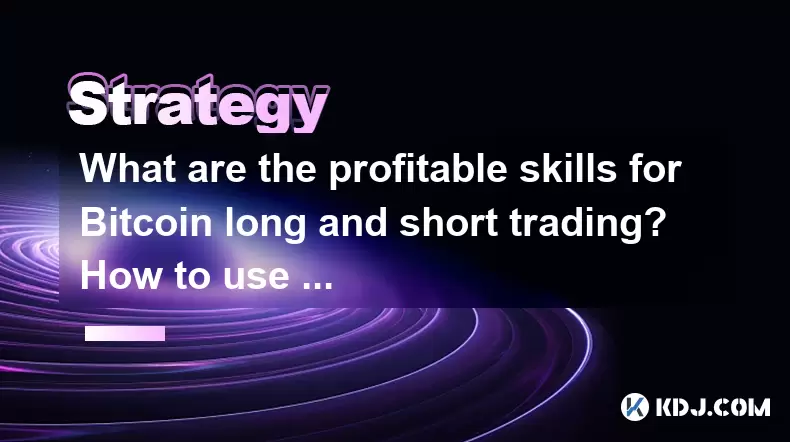-
 bitcoin
bitcoin $112195.049338 USD
2.42% -
 ethereum
ethereum $4124.915858 USD
2.81% -
 tether
tether $1.000570 USD
0.02% -
 xrp
xrp $2.861568 USD
2.25% -
 bnb
bnb $1000.346670 USD
3.04% -
 solana
solana $209.070819 USD
3.38% -
 usd-coin
usd-coin $0.999870 USD
0.02% -
 dogecoin
dogecoin $0.235379 USD
2.65% -
 tron
tron $0.335681 USD
-0.20% -
 cardano
cardano $0.803501 USD
3.38% -
 hyperliquid
hyperliquid $47.120881 USD
3.56% -
 chainlink
chainlink $21.501300 USD
3.44% -
 ethena-usde
ethena-usde $1.000571 USD
0.02% -
 avalanche
avalanche $29.793378 USD
3.62% -
 stellar
stellar $0.366964 USD
2.42%
What are the profitable skills for Bitcoin long and short trading? How to use Bitcoin to go long and short?
To succeed in Bitcoin trading, master technical and fundamental analysis, risk management, and emotional discipline, while using reliable platforms for long and short positions.
Jun 09, 2025 at 01:36 am

Bitcoin trading offers numerous opportunities for traders to profit from both rising and falling markets through long and short positions. Understanding the profitable skills required for Bitcoin long and short trading, as well as the practical steps to execute these trades, can significantly enhance your trading performance. This article delves into the essential skills and provides a detailed guide on how to use Bitcoin to go long and short.
Essential Skills for Bitcoin Long and Short Trading
Technical AnalysisTechnical analysis is a crucial skill for any Bitcoin trader, especially when engaging in long and short trading. This method involves analyzing historical price data and chart patterns to predict future price movements. Key aspects of technical analysis include understanding chart patterns, such as head and shoulders, double tops and bottoms, and trend lines. Additionally, traders should be proficient in using technical indicators like Moving Averages, Relative Strength Index (RSI), and Bollinger Bands to identify potential entry and exit points.
Fundamental AnalysisWhile technical analysis focuses on price movements, fundamental analysis examines the underlying factors that can influence Bitcoin's value. This includes studying news events, macroeconomic trends, and regulatory changes that could impact the cryptocurrency market. For long and short trading, understanding the fundamental drivers of Bitcoin's price can help traders make informed decisions about when to enter or exit positions.
Risk ManagementEffective risk management is essential for long-term success in Bitcoin trading. This involves setting clear stop-loss orders to limit potential losses and determining position sizes based on your risk tolerance. Additionally, traders should diversify their portfolios to mitigate the risk of significant losses from any single trade. Understanding and implementing proper risk management strategies can help protect your capital and maximize returns.
Emotional DisciplineTrading, particularly in the volatile cryptocurrency market, can be emotionally challenging. Emotional discipline is a vital skill that allows traders to stick to their trading plans and avoid making impulsive decisions based on fear or greed. Developing a disciplined approach to trading involves setting clear trading rules, sticking to a trading strategy, and maintaining a level-headed approach even during market turbulence.
Trading PsychologyClosely related to emotional discipline, trading psychology involves understanding your own psychological biases and how they can impact your trading decisions. Common biases include confirmation bias, where traders seek information that confirms their beliefs, and loss aversion, where the fear of losses leads to poor decision-making. By recognizing and managing these biases, traders can improve their decision-making process and enhance their trading performance.
How to Use Bitcoin to Go Long
Going long on Bitcoin means buying the cryptocurrency with the expectation that its price will rise. Here are the steps to go long on Bitcoin:
Choose a Trading Platform: Select a reputable cryptocurrency exchange that offers Bitcoin trading. Popular platforms include Binance, Coinbase, and Kraken. Ensure the platform is secure and offers the features you need for your trading strategy.
Fund Your Account: Deposit funds into your trading account using a supported payment method, such as bank transfer, credit card, or another cryptocurrency. Follow the platform's instructions to complete the deposit process.
Place a Buy Order: Navigate to the Bitcoin trading pair on the exchange and place a buy order. You can choose between a market order, which executes immediately at the current market price, or a limit order, which allows you to set a specific price at which you want to buy.
Monitor and Manage Your Position: After your buy order is filled, monitor the market and your position. Set a stop-loss order to limit potential losses if the market moves against you. Consider setting a take-profit order to automatically sell your Bitcoin when it reaches a certain price level.
Close Your Position: When you are ready to exit your long position, place a sell order to convert your Bitcoin back into your preferred currency. You can use a market order for immediate execution or a limit order to sell at a specific price.
How to Use Bitcoin to Go Short
Going short on Bitcoin means selling the cryptocurrency with the expectation that its price will fall. Here are the steps to go short on Bitcoin:
Choose a Trading Platform with Short Selling Capabilities: Not all exchanges offer short selling capabilities, so choose a platform that supports this feature. Examples include BitMEX, Binance Futures, and Kraken.
Fund Your Account: Deposit funds into your trading account, similar to the process for going long. Ensure you have enough margin to cover your short position, as short selling involves borrowing assets.
Place a Short Order: Navigate to the Bitcoin trading pair and place a short order. This typically involves borrowing Bitcoin from the exchange and selling it at the current market price. You can use a market order for immediate execution or a limit order to sell at a specific price.
Monitor and Manage Your Position: After your short order is filled, monitor the market and your position. Set a stop-loss order to limit potential losses if the market moves against you. Consider setting a take-profit order to automatically buy back the borrowed Bitcoin when it reaches a certain price level.
Close Your Position: When you are ready to exit your short position, place a buy order to buy back the borrowed Bitcoin and return it to the lender. This closes your short position, and any profits or losses are realized based on the difference between the selling and buying prices.
Tools and Resources for Bitcoin Long and Short Trading
To enhance your Bitcoin long and short trading, consider utilizing the following tools and resources:
Trading SoftwareTrading software can provide advanced charting tools, real-time market data, and automated trading capabilities. Platforms like TradingView and MetaTrader 4 are popular among traders for their comprehensive features and user-friendly interfaces.
Crypto News WebsitesStaying informed about the latest developments in the cryptocurrency market is crucial for both long and short trading. Websites like CoinDesk, CoinTelegraph, and CryptoSlate offer up-to-date news, analysis, and market insights that can help you make informed trading decisions.
Trading CommunitiesJoining trading communities can provide valuable insights and support from experienced traders. Platforms like Reddit, Telegram, and Discord host numerous cryptocurrency trading groups where members share ideas, strategies, and market analysis.
Educational ResourcesContinuous learning is essential for improving your trading skills. Educational resources such as online courses, webinars, and books can help you deepen your understanding of technical analysis, fundamental analysis, and trading psychology. Websites like Coursera, Udemy, and Investopedia offer a wide range of courses tailored to cryptocurrency trading.
Common Mistakes to Avoid in Bitcoin Long and Short Trading
Avoiding common pitfalls can help you improve your trading performance and minimize losses. Here are some mistakes to watch out for:
OverleveragingOverleveraging involves using excessive borrowed funds to amplify your trading positions. While leverage can increase potential profits, it also magnifies losses. Always use leverage cautiously and ensure you have a solid risk management strategy in place.
Ignoring Market TrendsFailing to recognize and adapt to market trends can lead to significant losses. Whether going long or short, it's essential to analyze the overall market direction and adjust your trading strategy accordingly.
Chasing LossesAttempting to recover losses by increasing your trading activity, known as chasing losses, often leads to further losses. Stick to your trading plan and avoid making impulsive decisions based on recent performance.
Neglecting Risk ManagementNeglecting risk management can result in substantial losses. Always set stop-loss orders and adhere to your risk management rules, even if it means missing out on potential profits.
Frequently Asked Questions
Q: Can I go long and short on Bitcoin at the same time?A: Yes, it is possible to go long and short on Bitcoin simultaneously, a strategy known as hedging. This can help you manage risk by offsetting potential losses in one position with gains in the other. However, it requires careful management and a clear understanding of the market dynamics.
Q: What is the difference between spot trading and futures trading for Bitcoin?A: Spot trading involves buying or selling Bitcoin for immediate delivery, while futures trading involves contracts to buy or sell Bitcoin at a future date. Futures trading allows for leverage and short selling, which are not typically available in spot trading.
Q: How much capital do I need to start Bitcoin long and short trading?A: The amount of capital required depends on your trading strategy and risk tolerance. For spot trading, you can start with a relatively small amount, but for futures trading, you may need more capital due to margin requirements. It's important to start with an amount you can afford to lose and to scale your trading as you gain experience.
Q: Are there any tax implications for Bitcoin long and short trading?A: Yes, Bitcoin trading can have tax implications depending on your jurisdiction. Profits from trading are typically subject to capital gains tax, and losses may be deductible. It's advisable to consult with a tax professional to understand the specific tax laws in your area and how they apply to your trading activities.
Disclaimer:info@kdj.com
The information provided is not trading advice. kdj.com does not assume any responsibility for any investments made based on the information provided in this article. Cryptocurrencies are highly volatile and it is highly recommended that you invest with caution after thorough research!
If you believe that the content used on this website infringes your copyright, please contact us immediately (info@kdj.com) and we will delete it promptly.
- Navigating Misinformation: Ensuring Safety in the Pi Network Ecosystem
- 2025-09-29 14:25:13
- XRP Price Prediction: September 29th's Crypto Comeback?
- 2025-09-29 14:25:13
- Polkadot vs. Lyno AI: Decoding the Price Forecast and AI Revolution
- 2025-09-29 14:30:01
- Trump's Brahmastra: Can Stable Coin Save the US Economy?
- 2025-09-29 14:45:17
- Pi Movement: Utility, Community, and the $314,159 Dream
- 2025-09-29 14:45:17
- Ruvi AI: Revolutionizing the Creator Economy with AI-Powered Crypto
- 2025-09-29 14:30:01
Related knowledge

Practical parameter settings for a Bitcoin multi-timeframe moving average system
Sep 18,2025 at 10:54pm
Optimizing Timeframe Combinations for Bitcoin Trading1. Selecting appropriate timeframes is crucial when building a multi-timeframe moving average sys...

How can I filter out false breakouts in Dogecoin high-frequency trading?
Sep 22,2025 at 01:00am
Understanding False Breakouts in Dogecoin Trading1. A false breakout occurs when Dogecoin's price appears to move beyond a defined support or resistan...

Techniques for identifying tops and bottoms in the Bitcoin on-chain NVT model
Sep 20,2025 at 07:54pm
Understanding the NVT Model in Bitcoin Analysis1. The Network Value to Transactions (NVT) ratio is often described as the 'P/E ratio' of the cryptocur...

What does the surge in open interest in Bitcoincoin futures mean?
Sep 20,2025 at 11:18pm
Understanding the Surge in Dogecoin Futures Open Interest1. A surge in open interest within Dogecoin futures indicates a growing number of active cont...

How can I use the Ethereum USDT premium to gauge market sentiment?
Sep 18,2025 at 11:55pm
Understanding the Ethereum USDT Premium1. The Ethereum USDT premium refers to the price difference between USDT (Tether) traded on Ethereum-based plat...

What should I do if Ethereum staking yields decline?
Sep 20,2025 at 06:18am
Understanding the Causes Behind Declining Ethereum Staking Yields1. The Ethereum network transitioned to a proof-of-stake consensus mechanism with the...

Practical parameter settings for a Bitcoin multi-timeframe moving average system
Sep 18,2025 at 10:54pm
Optimizing Timeframe Combinations for Bitcoin Trading1. Selecting appropriate timeframes is crucial when building a multi-timeframe moving average sys...

How can I filter out false breakouts in Dogecoin high-frequency trading?
Sep 22,2025 at 01:00am
Understanding False Breakouts in Dogecoin Trading1. A false breakout occurs when Dogecoin's price appears to move beyond a defined support or resistan...

Techniques for identifying tops and bottoms in the Bitcoin on-chain NVT model
Sep 20,2025 at 07:54pm
Understanding the NVT Model in Bitcoin Analysis1. The Network Value to Transactions (NVT) ratio is often described as the 'P/E ratio' of the cryptocur...

What does the surge in open interest in Bitcoincoin futures mean?
Sep 20,2025 at 11:18pm
Understanding the Surge in Dogecoin Futures Open Interest1. A surge in open interest within Dogecoin futures indicates a growing number of active cont...

How can I use the Ethereum USDT premium to gauge market sentiment?
Sep 18,2025 at 11:55pm
Understanding the Ethereum USDT Premium1. The Ethereum USDT premium refers to the price difference between USDT (Tether) traded on Ethereum-based plat...

What should I do if Ethereum staking yields decline?
Sep 20,2025 at 06:18am
Understanding the Causes Behind Declining Ethereum Staking Yields1. The Ethereum network transitioned to a proof-of-stake consensus mechanism with the...
See all articles










































































